
Introduction to Hacking Thick Clients: Part 6 – The Memory
Introduction to Hacking Thick Clients is a series of blog posts that will outline many of the tools and methodologies used when performing thick client security assessments. In conjunction with these posts, NetSPI has released two vulnerable thick clients: BetaFast, a premier Betamax movie rental service, and Beta Bank, a premier finance application for the elite. Many examples in this series will be taken directly from these applications, which can be downloaded from the BetaFast GitHub repo. A brief overview is covered in a previous blog post.
Installments:
Overview
Welcome to the final installment of Introduction to Hacking Thick Clients! What a journey. We’ve learned a lot, but there’s just one last thing to mention – the memory!
Viewing Data
If a system is compromised by an attacker, values stored in memory may be exposed. Of course, if an attacker has compromised a system to the point of analyzing memory, there are a lot of other issues. But it is my opinion that an application should take responsibility for its security as much as possible and not rely on the security of the system it resides on. I go further into some solutions and their practicalities in my freshman blog post, but most of them are focused on limiting exposure, not eliminating exposure. If possible, assign sensitive data to mutable data types, such as arrays. Immutable data types like strings cannot be cleared from memory on command, but an array can be cleared from memory as soon as its values are no longer needed.
So let’s see how Beta Bank handles its sensitive data. I’ll let it slide if I’ve logged in and the password is still in memory. But in this example, I’ve already authenticated to the application, logged out, and meandered through my studio apartment for a few minutes. That’s enough leeway – time to examine the application’s memory. First, find the application in Task Manager, right click, and click “Create dump file.”

Now, a likely massive file has been generated. That’s everything from that process’s memory. And thankfully, friendly neighborhood Mark Russinovich has created a tool called Strings that will help to analyze this data by retrieving only the string values. I’ve taken the liberty of running the following line in PowerShell:
.strings.exe .BetaBank.DMP | Out-File -FilePath .BetaBank.DMP.txt
The resultant file should be a much more manageable size, and any text editor worth its salt can search for values of choice. The password I used when logging in was NetSPI1!. And it shows up a lot.
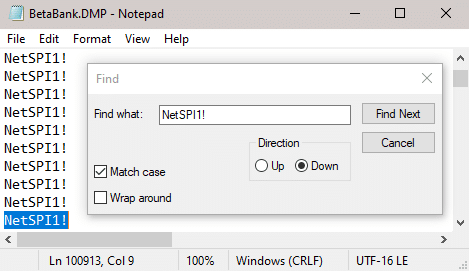
Another choice is to just open the entire dump file in a hex editor like HxD. The password appears just as easily and visibly, but so does a lot of other data.
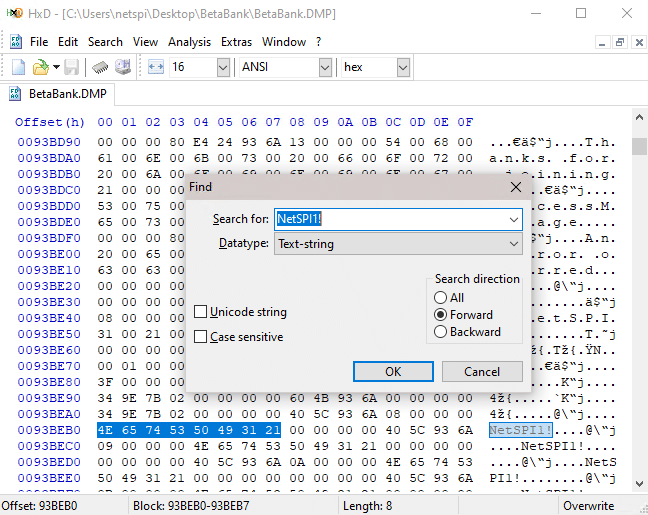
Modifying Data
As I was coming up with examples for this portion of the blog, I realized that I first began modifying data in memory as a delinquent child. If you were at all like me growing up and wanted to impress people with lies, you may remember Cheat Engine. Just like my Beta Bank password, game data such as item counts, experience points, and high scores may be in memory plain as day. And these values could be located through a simple search, and the data at that address could be changed to a new value. That level 25 character was a few clicks away from being level 2,147,483,647.
These days, it is much more difficult to earn the admiration of my peers through lies. But gosh darn it, I’m going to try. I’ve heard from previous installments in this blog series that there’s a user named The_Chairman who has a lot of money. I’m going to withdraw a lot of it. The plan is to change my username in memory to The_Chairman. Since the space for the username will already be allocated, I’ve created an account with the same username length – The_Flairman.

This account is going to be swamped with overdraft fees. In Wireshark, a SQL statement to withdraw money is being sent with the username The_Flairman. For the sake of this example, let’s just use this as verification and pretend the traffic is encrypted. And that a bunch of other security vulnerabilities are patched while still allowing me to do something like this.
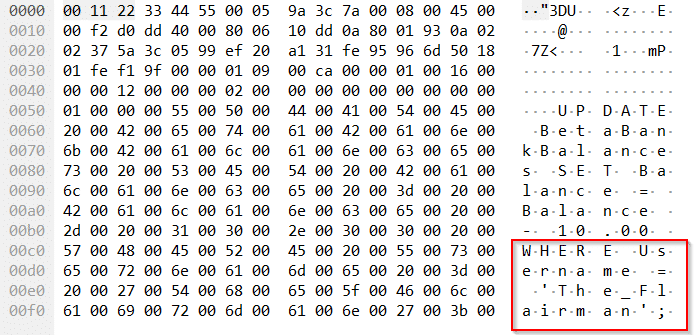
HxD is just as usable for editing memory as it is viewing, so we’ll stick with what we know. With Beta Bank running, click Open RAM to view the live memory for the process.
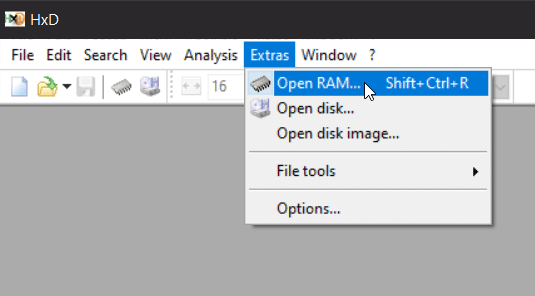
Searching for The_Flairman shows a number of locations where the username is referenced in memory.
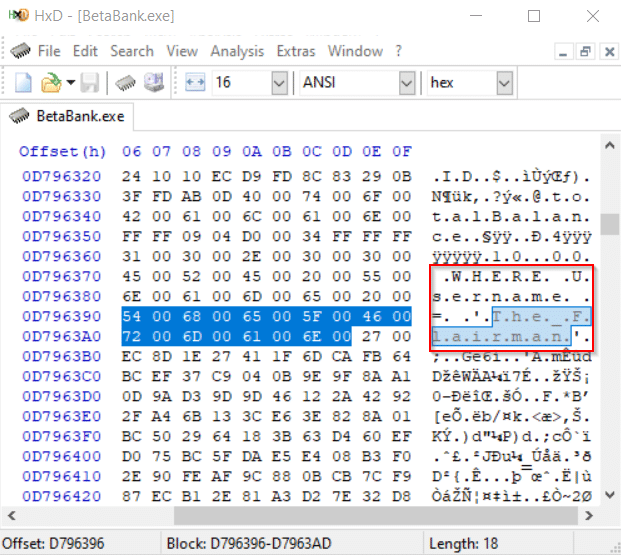
I went ahead and replaced every instance of The_Flairman with The_Chairman.
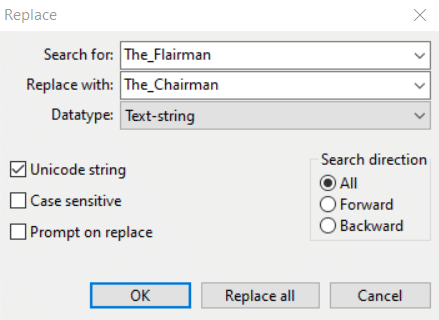
Below is one of these instances.
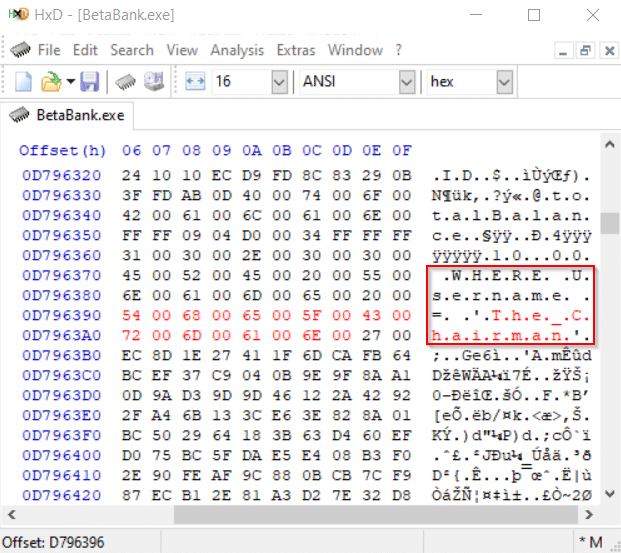
Saving these edits will overwrite the current live memory.
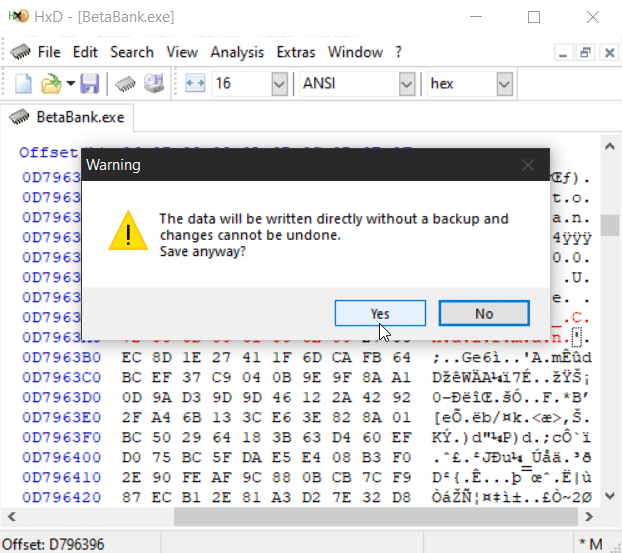
Back in the application, it’s clear that these changes went into effect. But were they functional?

Using Wireshark, I was able to verify that the Withdraw button will now send a SQL command to withdraw a large amount of money with the username The_Chairman.
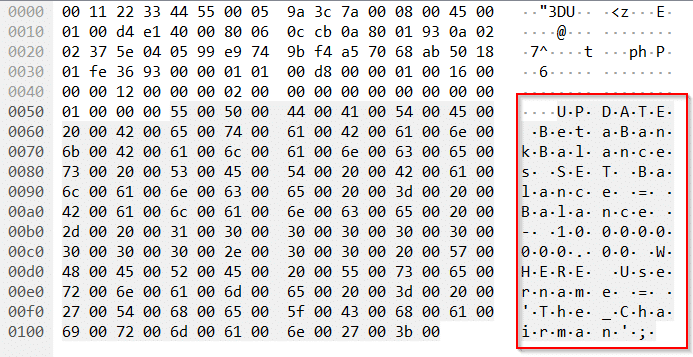
This wouldn’t be an issue at all if the SQL command wasn’t written with a complete lack of security awareness. In this application, there’s not a lot going on that would be “vulnerable” to memory values changing since authorization and storage is all on the server. Others may have simple boolean controls that can be bypassed through memory editing. Plenty of client-side control logic could be bypassed. I even found a simple example involving WinRAR, everyone’s favorite application, and how to bypass its registration control.
Further Reading
This blog post barely scratched the surface of memory analysis. The techniques outlined above are a few that are used during our routine testing of thick client applications. But they’re also entry points for diving further into malware analysis and reverse engineering. The following resources may be helpful starting points for additional learning:
- PowerShellArnsenal
- Volatility Framework
- A debugger such as x64dbg
Introduction to Hacking Thick Clients: The Conclusion
This series outlined quite a few thick client application testing methods and tools at a high level. While it never went especially deep on any one topic, I hope that it, along with BetaFast and Beta Bank, have opened the door for people to develop new security testing skills while having a bit of fun. This is a service line that really pushes creative thinking. Some of the exploitation steps I’ve seen in reports have made me reach out to coworkers and ask how they even thought to try them. Every once in a while, they unmute me and reply. But I digress . . .
Explore More Blog Posts

How Often Should Organizations Conduct Penetration Tests?
Learn how often organizations should conduct penetration tests. Discover industry best practices, key factors influencing testing frequency, and why regular pentesting is essential for business security.

Mainframe State of the Platform: 2025 Security Assessment
Learn key insights into mainframe security in 2025, including trends, gaps, and strategies to enhance protection for critical enterprise systems.

The Penetration Testing Life Cycle Explained
Learn about the 5 phases of penetration testing and how this structured process uncovers vulnerabilities and strengthens your cybersecurity defenses.